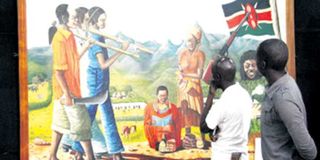Why our National Archives should be opened up

Art lovers admire a painting at the Kenya National Archives. PHOTO/FILE
What you need to know:
- Thousands of city dwellers converge on the facility daily, to wait for dates and to meet friends
- . The National Museums of Kenya manages more than 20 museums, galleries, historic and prehistoric sites spread across the country.
To most residents of Nairobi, the Kenya National Archives is popular for reasons other than the primary purpose of being the country’s chief memory bank.
This national facility is a prominent landmark and rendezvous, owing to its centrality within the city centre and distinctive architecture.
Thousands of city dwellers converge on the facility daily, to wait for dates and to meet friends. With multitudes coming here every day, the location is a rich hunting ground for street preachers, gamblers, hawkers and even cons.
It a wonder, then, that most of the people who meet the National Archives gates have entered the building nor do they know what goes on behind its walls.
RESOURCE CENTRE
For a national resource centre of its significance and stature, the only one of its kind countrywide, only a handful of people enter it every day. These visitors, mostly researchers, will be seen moving through the different sections on the building’s ground floor, quietly peeking at and taking notes from stacks of records, artefacts and photos that define Kenya’s history and culture. An earshot away, the chaotic city life goes on.
Kenya has done remarkably well in the preservation of its cultural heritage, sites and important monuments. The National Museums of Kenya manages more than 20 museums, galleries, historic and prehistoric sites spread across the country.
By paying a small fee, the public and tourists alike can access these facilities to learn about the country’s history.
It is different, though, with some public archives and public records of memorable national events. While many Kenyans would want to see records of national importance, some of these are not available. Where some of these records are preserved is a state secret.
Records from various presidencies, including speeches, executives orders and presidential standards for past heads of state, for instance, are accessible only to a handful of individuals, mostly senior government officials.
Under the Kenya Public Archives and Documentation Service Act (2003), the director of the National Archives is mandated to examine, care for and determine custody of all public records.
REGULATE CONDITIONS
It’s also the responsibility of the director to ‘‘regulate conditions’’ for inspection of these records by any interested Kenyan. Notably, the director of National Archives has the power to limit access to some records for any period for reasons that he they may deem fit.
It is this gap in preservation and accessibility that inspired veteran journalist Gitau wa Njenga to produce and publish institutional yearbooks as a tool to preserve important memories.
For a journalist who spent nearly two decades covering major events in the UK and across Europe, preservation of memories has a special place in his heart.
The need to correct his past blunders, where he failed to capture historical moments when he could, have partly been the thrust behind this project.
One such gaffe took place in the summer of 2005 in the UK, where Njenga, then the Europe correspondent for local dailies, had been invited for a garden party at the Buckingham Palace.
Coinciding with his birthday, Njenga was determined to make the invitation, seconded by the association of foreign journalists in the UK (FPA), memorable.
‘‘I donned a Maasai shuka, akala shoes and other Afrocentric jewellery,’’ he narrates.
At the event, Njenga was a spectacle to behold, which helped him to freely mingle with the royalty and notable personalities in the British aristocracy.
‘‘Everyone wanted to take a photo with me. So many pictures were taken, none which I got to keep,’’ adds he with a mixture of nostalgia and rue. ‘‘I failed to capture a moment of a lifetime.’’
After 17 years in the United Kingdom, Njenga returned to Kenya in 2015 to start a publishing company. His mission was to create souvenir yearbooks for various institutions in Kenya. For the British-trained journalist, high schools were a good place to start.
FOND MEMORIES
‘‘There are so many fond memories to capture in high school because this is the age of discovery for adolescents,’’ Njenga explains. ‘‘From academics, sports, friendships and other co-curricular activities, life in high school is the most exciting and carefree period in life. Yearbooks give students an opportunity to reflect upon the people and events that shaped their lives,’’ he adds.
Last year, his company, School Yearbook Publishers (SYP), produced a yearbook for Alliance Girls High School to public acclaim. Being the inaugural edition, this yearbook captured the national girls school’s history since its establishment by missionaries in 1948. It also featured different generations of students and teachers who went through its gates, including national leaders and opinion shapers.
In only slightly over 240 pages of colourful pictures, the 71-year history of the school was told.
Njenga argues that in a world where everything moves so fast, details of people and events slip off the radar and are replaced by others. Important dates, appointments and even anniversaries have never been easier to forget. Without reminders, the world would be a chaotic place to live in.
PRESERVE MEMORIES
This isn’t helped by the daily information overload either. Recalling details of events that took place five years ago is a mental chore that most people would avoid.
‘‘While you can appreciate how time flies and events fade, a yearbook preserves those lasting memories for life,’’ Njenga notes.
He adds that pilot projects for Kapsabet High School, Kenya High School and Mary Hill Girls School are in the pipeline.
The digital space, particularly social media, has dramatically revolutionised how people capture and preserve memories of events they hold dear through photos and videos.
For millennials, it is possible today to capture one’s entire journey through university from admission to graduation through photo albums posted on Facebook or Instagram.
Njenga opines that the media in Kenya has ‘‘done considerably well’’ in preserving the country’s history.
‘‘Each of the media house has archival material in databases where events in pre-independence and post-independence Kenya are kept. Preservation has evolved from raw format to digital format, which is even more efficient,’’ he observes.
‘‘We are not well enriched in terms of preservation of our history. Records of events that are available aren’t easily accessible to the public,’’ Njenga says.
He proposes legislation that allows free access to these records by removing bureaucracy that inhibits access. Declassifying some records is critical in this endeavour, he says.
OPEN UP
‘‘The government needs to open up. Records about the country’s presidents, for instance, are public records. They aren’t private or personal property. The public has the right to access these materials whenever they want to,’’ Njenga argues.
‘‘What’s the point of preserving records if they can’t be accessed by those who need them?’’ he wonders.
While acknowledging the existence of the Presidential Reference Library, Njenga laments that this facility is ‘‘too centralised’’ and access to it limited to a few entities. This, he argues, defeats the rationale of its existence.
According to him, there is need for public awareness on the existence of materials to aid in academic, journalistic and historical reference.
But to nurture a generation that appreciates the importance of preserving records, Njenga notes that the journey has to start early on.
‘‘Schools must teach learners why it’s necessary to keep these records,’’ he says, adding that digital resources have made this easier.
‘‘There’s growing need for data. We need to avail these data through records and opening up avenues,’’ he adds.




